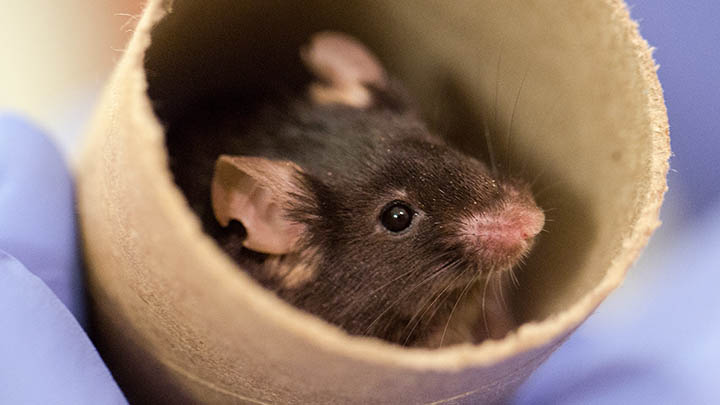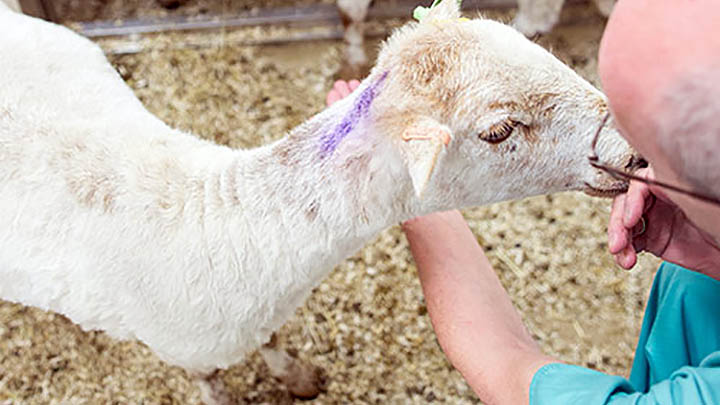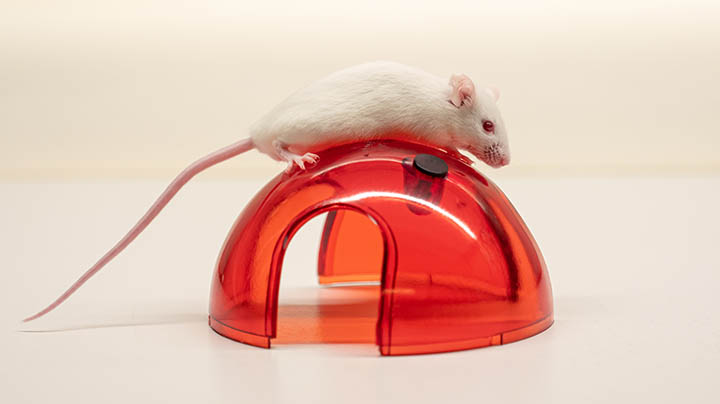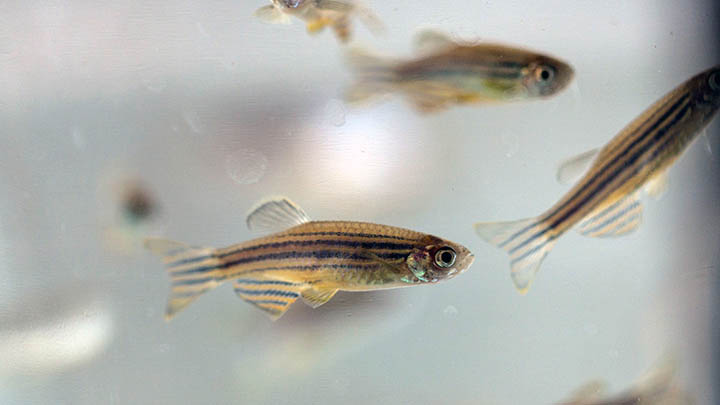World-class facilities supporting cutting-edge in vivo experimentation
The Biological Service Facility (BSF) comprises state-of-the-art facilities to investigate the fundamental biology that underpins health and disease in both man and animals.
We provide housing and care for a multitude of species of experimental animals. These include rodents (mice, rats, gerbils, Rhabdomys and guinea pigs), fish, amphibians, and small ungulates.
Animal care and experimental support is provided by a team of over thirty dedicated, highly skilled technical staff in association with veterinary support.
The BSF also offers in-house expertise and advice to enable and facilitate world-class research from inception through experimental design to study completion.
We can provide access to the facilities and the support of our expertise to external researchers.
More information about The University’s approach and ethical conduct can be found on our pages on research involving animals.
How we work
Supporting your animal research project
We provide facilities, equipment, advice, care and technical support for all aspects of research studies involving animals.
Our approach
We aim to engage with all researchers from the outset of their animal research experience. This begins with licence applications and continues with guidance, support and any required training.
We bring a ‘can do’ philosophy coupled with a strong culture of care.

Projects
We recognise there is an importance and need for study on a variety of animal species. This is reflected in the breadth of species we accommodate and the in-house expertise we provide.
This means projects are varied in size, scope and ambition. Yet they all inform on how physiological systems operate, how they change during the life course and disease, and how they can facilitate the development of new therapies when they fail.

Applications
Wide, in-depth experience of studying physiology, health and disease
Areas of study for the facility include:
- immune function: deficiency, autoimmune disease, immunity to infection, allergy and asthma;
- inflammation and fibrosis;
- infection: viral, bacterial, fungal and parasitic;
- cancer and therapies;
- neurosciences: dementias, vision, stroke, and behaviour;
- cardiovascular disease and hypertension;
- metabolic disease and obesity, feeding and nutrition;
- circadian biology;
- stem cells;
- musculoskeletal disease;
- renal biology;
- organismal development;
- wound healing.
Technologies and equipment
Multiple in vivo technologies
The BSF accommodates multiple in vivo technologies to facilitate the diverse array of in vivo research we undertake.
These technologies include:
Fully equipped surgical suites for large and small animals, with additional technical/surgical support.
The University of Manchester Axenic and Gnotobiotic facility has C57BL/6 and Rag 1 KO germ-free mice, that were procured from the University of Bern, Switzerland. We provide support with germ free and gnotobiotic mouse models, with expertise in the generation and long-term maintenance of mono-colonised and/or minimally diverse microbiota gnotobiotic mice.
Within a germ-free environment, we can also provide experimental and technical support for the use of infectious agents (both single and multicellular pathogenic models). The facility includes double-tier breeding isolators and smaller box isolators available for experimental use in addition to a Tecniplast iso-cage system.
Linked in vivo imaging facilities, including: MRI, PET/CT, SPECT/CT, fluorescent bioluminescence optical imaging, ultrasound, OCT imaging and 2-photon intra vital microscopy.
Metabolic assessment including calorimetery, feeding monitoring, body composition analysis.
Cardiovascular assessment including conscious and unconscious ECG, non-invasive and invasive blood pressure assessment, laser Doppler and speckle blood flow assessment.
Behavioural assessment suites with multiple novel object recognition assessment methodologies, maze and open field assessments, operant boxes, circadian activity control and assessment.
Specialist methodologies, including optogenetic modulation, whole body and area irradiation, vision assessment methodologies, lung function assessment.
These facilities benefit from our close links with the Genome Editing technology platform.
External access
Academic and industrial partners
Both academic and industrial partners outside of the University interact with many of our animal focussed researchers through collaborations, with appropriate licensing arrangements in place.
Our ongoing research determines our capacity to take on external work, but we have a large facility with a proactive and positive approach to external partners.
If you are interested in accessing the facilities please contact:
Dr Maria Kamper, BSF Director.
Email: maria.kamper@manchester.ac.uk

Established processes
We have long-standing collaborations with multiple industrial contract research organisations, pharmaceutical companies and other regional academic establishments, especially in the North West.
All work is fully documented and performed under relevant contractual agreements. We are always keen to talk to interested parties who wish to explore the possibilities of animal-based research utilising the infrastructure and expertise together with the broad range of species and varied techniques available within the BSF in Manchester.

Publications and outputs
Underpinning research in a wide variety of disciplines
The BSF supports research in a wide variety of biological and biomedical disciplines, leading to outputs in prominent academic journals.
Here are some of the highlights.
Nature Immunology, 2019.
Macrophages found in the lung play important roles in protecting against infection and respiratory allergies. We have discovered that the lung environment profoundly influences the capacity of the lung to mount immune responses through altered cell metabolism, in particular using glucose as an energy source. Importantly, once lung macrophages were removed from the lung environment they showed a completely different response profile highlighting the importance of using in vivo systems to define immune function.
F1000Research, 2018.
We used genetic and chemically induced Zebrafish models of intracerebral haemorrhage to assess their usefulness in the study of stroke. We found remarkable similarities to key features of human stoke, and identified the migration of macrophages to the site of injury. The capacity to image the movement of these cells in real time using transgenic Zebrafish, opens up new possibilities for understanding the mechanisms underlying stroke and should prove a very useful model for pre-clinical work going forward.
eLife, 2020.
We identified a subset of neurons that respond to GDF15, a cytokine whose overexpression in pathological states is linked to dramatic weight loss. Cisplatin, a common cancer chemotherapeutic agent, was shown to induce GDF15 release and activate these neurons, causing a reduction in food intake and body weight, mirroring the side effects experienced by cancer patients. However, pre-treatment with a monoclonal antibody specific for the GDF15 receptor abolished these effects, suggesting that neutralising antibodies or antagonists may provide a co-treatment opportunity for patients undergoing chemotherapy.
- DOI: 10.7554/eLife.55164
Proceedings of the National Academy of Science USA, 2021.
Using a diurnal rodent species, Rhabdomys pumilio, we show that increasing the intensity of daytime light enhances the reproducibility and robustness of behavioral and physiological rhythms, and increases the amplitude of circadian rhythms in electrical activity in the central brain pacemaker. These findings reveal an impact of light on circadian amplitude and highlight the potential importance of daytime light exposure for circadian health.
Circulation Research, 2021.
Using an integrative whole animal and cellular approach, we have investigated the impact of PDE5 inhibition in a drug-induced sheep arrhythmia model. We found that sildenafil dramatically reduced the incidence and delayed the occurrence of afterdepolarizations, premature ventricular complexes, and Torsades de Pointes in vivo, and these effects were attributable to a PKG-dependent effect on Ca2+ waves and involved a reduction in SR Ca2+ content.
Proceedings of the National Academy of Science USA, 2018.
The Xenopus tropicalis tadpole skin is a powerful model system to study mucosal epithelia, which are often limited in mammalian systems due to their internal location. We have characterized the major structural component of the X. tropicalis barrier and shown that it is a mucin glycoprotein with similar sequence, domain organization, and structural properties to human gel-forming mucins, and protects against microbial infection. Our findings therefore characterize an accessible and tractable model system to define mucus barrier function and host–microbe interactions.
Contact us
Get in touch
For further information or to inquire about using our facility, contact:
Dr Maria Kamper, BSF Director
Technology platforms
Technology platforms
We have a pioneering environment and facilities for research, innovation and technology development.
Technology platforms main page
